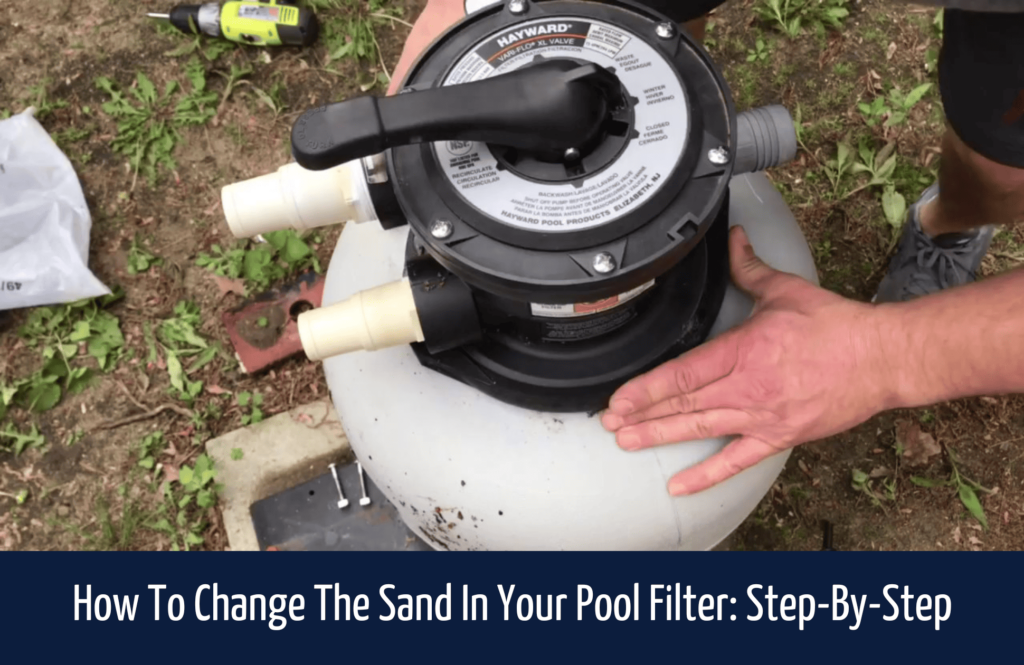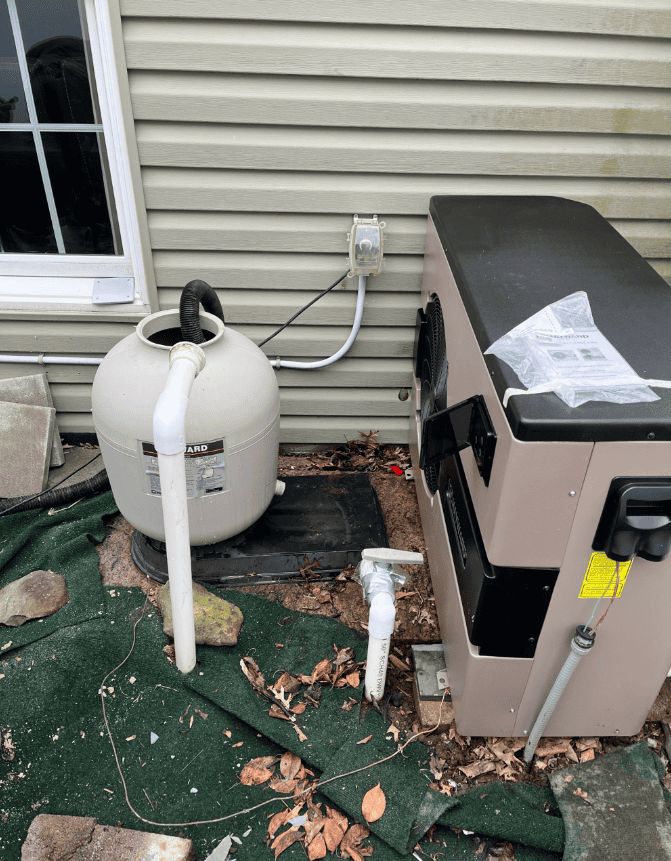
Welcome to our comprehensive guide on an essential aspect of pool maintenance – changing the sand in your pool filter.
As a pool service professional, we know that your pool is more than just a place to cool off during the summer; it’s a hub of enjoyment and relaxation for your family.
Maintaining its pristine condition is vital to prolonging those happy moments, and that’s where changing the sand in your pool filter comes into play.

The sand in your pool filter is crucial in keeping your pool water clear and clean.
Over time, this sand becomes clogged with debris and loses its effectiveness in trapping and removing impurities.
This is why it is necessary to replace the sand regularly. Failing to do so may result in cloudy water and create an environment conducive to algae growth and other unwanted contaminants.
In this guide, we’ll provide the following:
We understand that pool maintenance can seem daunting, but we assure you that it becomes a manageable and even satisfying task with the proper guidance.
Regarding time requirements, expect changing the sand in your pool filter to take several hours.
However, this investment of time could be more frequent. Under normal circumstances, we recommend changing the sand in your pool filter every 5-7 years. Yet, the exact frequency will depend on the usage of your pool and the condition of your current sand filter.
Before diving into the step-by-step guide, it’s crucial to be prepared with all the necessary tools and materials to change the sand in your pool filter.
Here’s a handy checklist to ensure you have everything you need:

You can purchase most of these materials from a local pool supply store or online from reputable pool equipment retailers. Remember, investing in high-quality materials and tools makes the job easier and contributes to the longevity and effectiveness of your pool filter.
When buying pool filter sand, check its compatibility with your specific filter model. Not all filters use the same type of sand. Therefore, consulting your filter’s manual or getting advice from pool service professionals like ourselves can be beneficial.
With the right tools and materials at your disposal, you’ll be well-prepared to change the sand in your pool filter. In the next section, we’ll discuss safety precautions to protect you during this process.

Safety is paramount in every aspect of pool maintenance, including when changing the sand in your pool filter.
Here are some crucial safety tips to keep in mind before you begin this process:
As pool service experts, we cannot stress enough the importance of these safety measures. They are meant to protect you and ensure the process goes smoothly.
Now, with the right tools and safety measures in place, let’s get into the step-by-step guide on changing the sand in your pool filter.
As we embark on this critical pool maintenance task, we’ll guide you through each step with detail and precision. With the right tools, safety measures, and an expert guide, you can effectively and efficiently change the sand in your pool filter.
Draining the pool filter is the first crucial step in this process.
To ensure a thorough and effective sand replacement, it is important to properly drain the water from the sand filter.
Here’s how to do it correctly:
These steps will ensure that you have safely and effectively drained the water from your pool filter, setting the stage for removing and replacing the old sand.
Remember, every pool filter is unique, so your valve might not have the same labels as described here. Always refer to your filter’s manual if unsure about the valve settings.
Now that you’ve safely drained the pool filter, it’s time to get down to the nitty-gritty and remove the filter for sand replacement.
While this might sound daunting, rest assured that it is a manageable task with the right steps.

With the old sand removed and the tank cleaned, this is the perfect time to thoroughly inspect your pool filter. Identifying and addressing any issues at this stage can prevent future problems and ensure the filter performs optimally with its fresh load of sand.
Here’s what to look for during the inspection:
With the filter cleaned and inspected, we’ve arrived at a critical juncture: adding the new sand. While this step might sound straightforward, it’s essential to do it correctly to ensure your filter works effectively.
Having successfully replaced the sand, it’s time to reassemble the pool filter and reattach it to the pool system. This step requires precision and care to ensure everything fits together correctly and the system works efficiently.
Remember, backwashing prepares new sand for operation and is a regular maintenance task you should perform whenever the pressure gauge indicates it’s needed. It helps keep your filter working effectively and your pool water crystal clear.
With this final step, you’ve successfully changed the sand in your pool filter.
Changing the sand in your pool filter is not an everyday task, but it’s crucial for the long-term health of your pool.
You’ve better understood how your pool operates by doing this work yourself. So here’s to clear, refreshing water and the satisfaction of a job well done!
Even for seasoned pool owners, changing the sand in a pool filter can have challenges.
However, being aware of common mistakes can help you avoid them and ensure the process goes smoothly.
By steering clear of these common mistakes, you’re setting yourself up for success in maintaining a healthy and clean pool.
Always remember that each pool and its accompanying system are unique, so when in doubt, feel free to consult with a pool service professional like us.
Congratulations on successfully changing the sand in your pool filter!
Now, let’s focus on maintaining your filter in top condition. By following a few key tips, you can extend the lifespan of your filter and ensure optimal performance.
Following these maintenance tips and staying proactive ensure your pool filter remains in optimal condition.
Remember, a well-maintained filter leads to cleaner water, reduced maintenance costs, and an enjoyable swimming experience.
As pool service experts, we often encounter questions regarding pool filter sand changes.
To address some common concerns, we’ve compiled a list of frequently asked questions and their answers:
How often should I change the sand in my pool filter?
The general recommendation is to change the sand in your pool filter every 5 to 7 years. However, the frequency can vary based on pool usage, water conditions, and your filter type. Regular maintenance and monitoring of the performance of your filter can help determine when it’s time for a sand change.
Can I use any sand for my pool filter?
No, using only sand designed explicitly for pool filters would be best. The most commonly recommended type is #20 silica sand. Other types of sand, such as play sand or beach sand, do not have the necessary properties for efficient filtration and can potentially damage your filter.
How do I know if my sand needs to be replaced?
A few signs that indicate the need for sand replacement include decreased water clarity, increased pressure on the gauge, and reduced filtration efficiency. If you notice these symptoms or it has been several years since the last sand change, it’s likely time to replace the sand.
Can I reuse the existing sand during a sand change?
Reusing the existing sand when changing your pool filter is generally not recommended. Over time, the sand becomes compacted, loses its filtration effectiveness, and accumulates debris. Starting fresh with new sand ensures optimal filtration performance.
Do I need to backwash and rinse after changing the sand?
Yes, it’s crucial to backwash and rinse the filter after changing the sand. Backwashing flushes out any fine particles or debris from the new sand, and rinsing helps re-compact the sand and remove any remaining impurities.
Can I change the sand in my pool filter myself, or should I hire a professional?
Changing the sand in a pool filter can be a DIY project for those with some experience and knowledge of pool maintenance. However, if you need clarification or are uncomfortable with the process, it’s always recommended to seek the assistance of a professional pool service provider. They have the expertise and tools to ensure the job is done correctly.
We hope these answers have clarified some common questions related to pool filter sand changes. If you have any additional inquiries or require further assistance, don’t hesitate to contact us.
In conclusion, changing the sand in your pool filter is a vital maintenance task that should be addressed. By replacing the sand at the appropriate intervals, you ensure the optimal performance of your pool filtration system, resulting in clean and clear water for your enjoyment.
Throughout this guide, we’ve emphasized the importance of proper maintenance, step-by-step instructions, and safety precautions. By following this comprehensive guide, you’ve taken a proactive step towards maintaining the health of your pool and prolonging its lifespan.
Remember, the sand in your pool filter is crucial in trapping impurities and keeping your pool water pristine. Over time, the sand becomes worn and less effective, so regular sand changes are necessary. Doing so prevents potential issues such as cloudy water, algae growth, and poor filtration.
We encourage you to use this guide as your go-to resource when changing the sand in your pool filter. By adhering to the steps outlined, utilizing the proper tools and materials, and maintaining a regular maintenance routine, you can ensure the longevity and efficiency of your pool filter.
If you have any questions or encounter difficulties during the process, don’t hesitate to contact our pool service experts. We provide guidance, support, and professional assistance to help you maintain your pool optimally.
Thank you for taking the time to prioritize the care of your pool. By following this guide, you’re investing in your pool’s long-term enjoyment and health, creating a refreshing oasis for you, your family, and your friends to enjoy for years.

We make pool ownership easy with stress-free maintenance, expert repairs, and cutting-edge tech. From sparkling water to pool automation, we handle every detail so you can relax and enjoy your pool.
© 2025 Paul Romanelli & Son Pool Service.